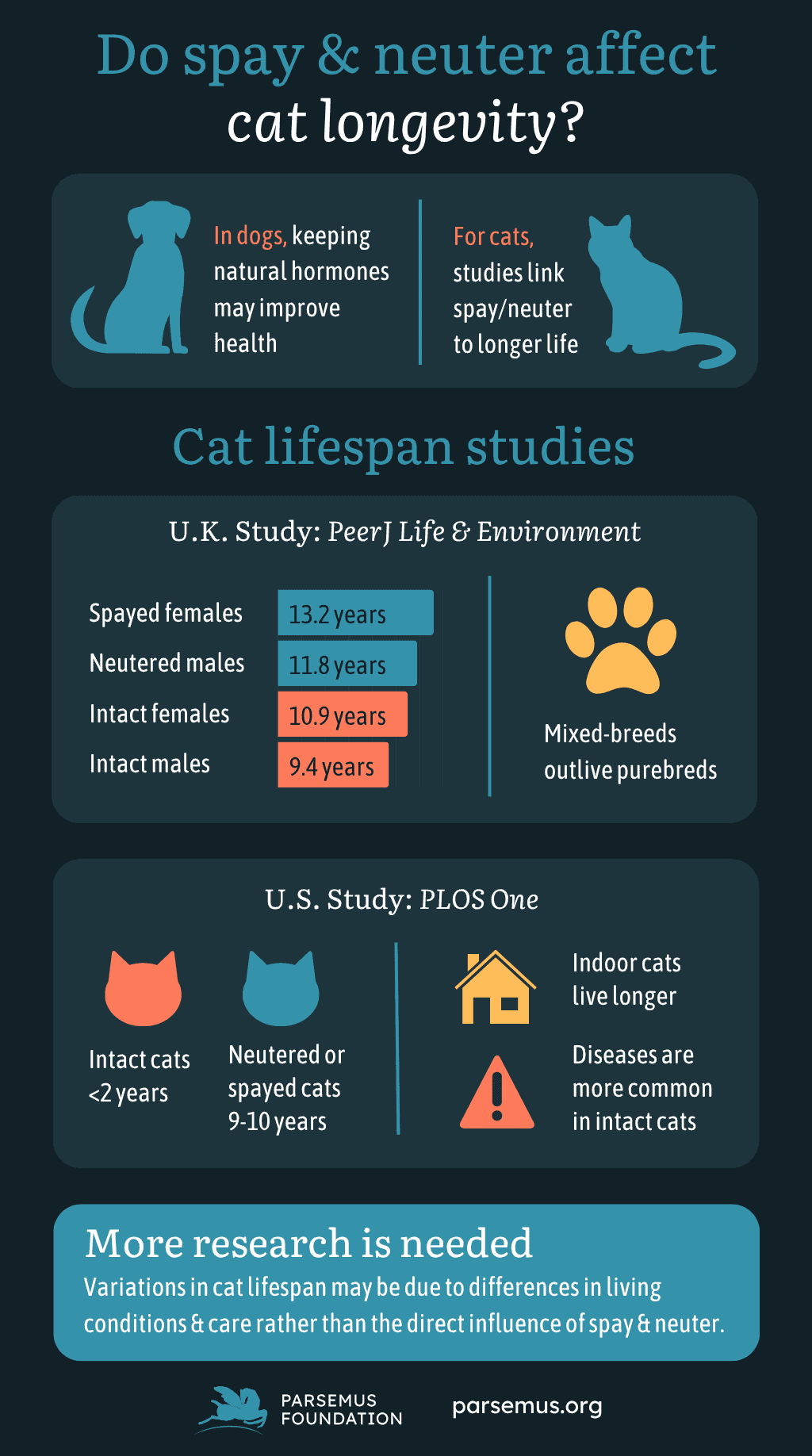Evidence is growing that dogs that have their natural gonadal (sex) hormones for longer experience increased longevity and health. This can be accomplished by leaving them intact, delaying spay or neuter, or sterilizing with hormone-sparing methods.
But is the same true for cats?
Two recent studies suggest that cats that have been spayed or neutered (also called gonadectomy) live longer — unlike dogs. This may be related to living conditions and the kind of healthcare that’s common for spayed and neutered cats.
Cat longevity is greatest for spayed mixed-breed females
A study published on January 30, 2025, in PeerJ Life & Environment analyzed veterinary records from 7,708 cats in the U.K. Researchers found that spayed and neutered cats lived longer than intact cats. Spayed females lived the longest at 13.2 years compared to 10.9 years for intact females. Neutered males lived 11.8 years, while intact males lived 9.4 years. The study also found that mixed-breed cats outlived purebred cats. This is likely due to the “hybrid vigor” that results from greater genetic diversity in mixed-breeds.
Another study, published on December 29, 2022, in PLOS One, reviewed necropsy records from over 3,000 cats in the U.S. Those researchers also found that spayed and neutered cats outlived intact cats. They had median lifespans over 9 years, compared with under two years for their intact counterparts. The data also showed that indoor cats lived longer than outdoor cats, and that diseases such as feline leukemia virus (FeLV) sharply reduced survival.
But do spaying and neutering directly affect cat longevity?
The results of the U.K. and U.S. studies are consistent with previous ones reporting that spayed and neutered cats lived longer than intact cats. An important follow-up question is whether the change in natural hormones due to spaying and neutering directly increases cat longevity, or if other factors are involved.
The relationship of neuter status, living conditions, and cause of death is important to consider. Intact cats are more likely to live outside, where they have a higher risk of trauma, infection, and reproductive disease. This is especially so with tom cats, whose life expectancy was found to be the lowest. Male cats have long been recognized as having higher mortality rates due to trauma from aggressive interactions with other cats, traffic accidents, and dog attacks. Road accidents account for the majority of deaths in male cats in the U.S. and other countries.
In the U.S., most pet cats that live indoors are spayed or neutered. That’s at least partly because their natural behaviors would be incompatible with most households. For male cats, those behaviors include spraying, and for females, they include vocalizations during heat. Very few intact indoor cats are available for research, as found in the 2022 study above. This makes it difficult for researchers to draw conclusions. It’s also possible that differences in veterinary care, nutrition, and environment are correlated with indoor living and sterilization status.
A comparison to dogs
The Parsemus Foundation has long raised awareness of the health downsides of gonadectomy in dogs. Spayed and neutered dogs may experience higher risks of cancers, obesity, urinary incontinence, thyroid disease, diabetes, and joint disorders. See our webpage on this topic. Some research has linked the high luteinizing hormone levels that result from hormonal imbalance after spaying and neutering to health problems throughout the body.
Research shows that dogs with longer exposure to their natural sex hormones tend to have better health outcomes. That’s why the foundation supports consideration of hormone-sparing sterilization options, like vasectomy or hysterectomy, for dogs.
While we’re regularly asked whether hormone-sparing sterilization should also be used to protect cat health, unfortunately, we don’t yet have the evidence we’d need. The studies outlined here indicate that spayed and neutered cats live longer, but this may be due to differences in living conditions and care.
More research is needed
The direct impact of gonadectomy on cat health is unclear. There’s evidence that gonadectomy increases luteinizing hormone in cats, as is known to occur in dogs. Yet while studies have shown that obesity is more common in spayed and neutered cats, there’s little consensus on whether gonadectomy is related to increases in cancer and other diseases as found in dogs.
It’s also unclear whether age at spay or neuter influences outcomes, and whether hormone-sparing sterilization would benefit cats. Given that most cat owners want the behavioral changes that come after spaying and neutering, there has been less call for research on the matter. We hope that over time, we’ll have a clearer picture of the influence of spaying and neutering on the long-term health and longevity of cats.
See our other news articles about hormone-sparing sterilization.



